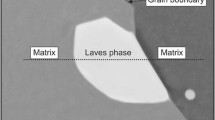Conclusions
-
1.
The quality of the metal in axial trepans, which was sampled from two large forgings, is satisfactory along the entire length: no cracks, flakes, or other defects that disturb the metal's continuity are detected.
-
2.
Nonmetallic inclusions are observed in the metal of the trepan: sulfides, oxides, and oxysulfides, arranged in the form of chains along the grain boundaries, and small lines in the direction of deformation; this exerts an unfavorable influence on the plastic and ductile properties of the forgings.
-
3.
The presence of a dendritic and banded macrostructure suggests inadequacies in plastic-deformation technology.
-
4.
The level of strength, plastic, and ductile characteristics of the metal after treatment in accordance with the new regime is lower, and the critical brittleness temperature higher by 30° C than after treatment in accordance with the regime previously adopted.
-
5.
The new regime for the preliminary heat treatment of large forgings ensures decomposition of the austenite in accordance with a diffusion mechanism and the production of a grain corresponding to Nos. 5–7 in the central zones; this is positively manifested in the properties of the metal after final heat treatment.
Similar content being viewed by others
Literature cited
A. A. Astaf'ev, I. A. Borisov, and V. S. Sheiko, „Heat treatment and properties of steel 24Kh2NMFA for welded rotors of low-speed turbines,” in: Effect of Heat Treatment on the Structure and Properties of Metal in Rotor Forgings, No. 3, Nauchno-Issled. Inst. Inf. Tyazhelykh Mashin, Moscow (1974), p. 1.
E. I. Kvashina, I. A. Borisov, and E. K. Smirnova, „Effect of cooling rate after austenizing on structural formation during the tempering of Cr−Ni−Mo−V steel,” in: Effect of Heat Treatment on the Structure and Properties of the Metal in Rotor Forgings, No. 3, Nauchno-Issled. Inst. Inf. Tyazhelykh Mashin, Moscow (1974), p. 8.
A. N. Minkov, I. A. Borisov, V. S. Sheiko, and L. D. Chentsova, „Optimizing heat-treatment processes for the median sections of rotors,” in: Machine-Building Technology, No. 4, Nauchno-Issled. Inst. Ekonom Inform. Énerg., Moscow (1983), p. 17.
I. A. Borisov, A. A. Astaf'ev, N. P. Kateeva, et al., „Technology of the heat treatment of steel 25Kh2NMFA as applies to welded rotor components,” in: Technology of the Heat Treatment of Rotor Forgings for Turbines and Turbine Generators, No. 2, Nauchno-Issled. Inst. Inf. Trazhelykh Mashin, Moscow (1974), pp. 1–5.
USSR Inventor's Certificate No. 1,272,713.
Additional information
Kramatorsk Plant „Energomashspetsstal'.” Translated from Metallovedenie i Termicheskaya Obrabotka Metallov, No. 6, pp. 47–51, June, 1990.
Rights and permissions
About this article
Cite this article
Sheiko, V.S., Koval'chenko, A.V., Cherednichenko, T.G. et al. Investigation of the quality of metal in large forgings formed from steel 25Kh2NMFA in the annealed state. Met Sci Heat Treat 32, 453–458 (1990). https://doi.org/10.1007/BF01100168
Issue Date:
DOI: https://doi.org/10.1007/BF01100168




